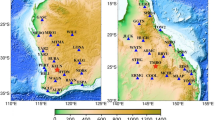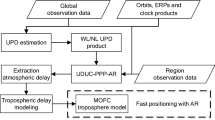Abstract
During past decades, precise point positioning (PPP) has been proven to be a well-known positioning technique for centimeter or decimeter level accuracy. However, it needs long convergence time to get high-accuracy positioning, which limits the prospects of PPP, especially in real-time applications. It is expected that the PPP convergence time can be reduced by introducing high-quality external information, such as ionospheric or tropospheric corrections. In this study, several methods for tropospheric wet delays modeling over wide areas are investigated. A new, improved model is developed, applicable in real-time applications in China. Based on the GPT2w model, a modified parameter of zenith wet delay exponential decay wrt. height is introduced in the modeling of the real-time tropospheric delay. The accuracy of this tropospheric model and GPT2w model in different seasons is evaluated with cross-validation, the root mean square of the zenith troposphere delay (ZTD) is 1.2 and 3.6 cm on average, respectively. On the other hand, this new model proves to be better than the tropospheric modeling based on water-vapor scale height; it can accurately express tropospheric delays up to 10 km altitude, which potentially has benefits in many real-time applications. With the high-accuracy ZTD model, the augmented PPP convergence performance for BeiDou navigation satellite system (BDS) and GPS is evaluated. It shows that the contribution of the high-quality ZTD model on PPP convergence performance has relation with the constellation geometry. As BDS constellation geometry is poorer than GPS, the improvement for BDS PPP is more significant than that for GPS PPP. Compared with standard real-time PPP, the convergence time is reduced by 2–7 and 20–50% for the augmented BDS PPP, while GPS PPP only improves about 6 and 18% (on average), in horizontal and vertical directions, respectively. When GPS and BDS are combined, the geometry is greatly improved, which is good enough to get a reliable PPP solution, the augmentation PPP improves insignificantly comparing with standard PPP.















Similar content being viewed by others
References
Ahmed F, Clavovic P, Teferle FN et al (2016) Comparative analysis of real-time precise point positioning zenith total delay estimates. GPS Solut 20(2):187–199
Askne J, Nordius H (1987) Estimation of tropospheric delay for microwaves from surface weather data. Radio Sci 22(3):379–386. https://doi.org/10.1029/RS022i003p00379
Blewitt G, Hammond WC, Kreemer C, Plag HP, Stein S, Okal E (2009) GPS for real-time earthquake source determination and tsunami warning systems. J Geod 83(3):335–343
Böhm J, Schuh H (2004) Vienna map** functions in VLBI analyses. Geophys Res Lett 31:L01603. https://doi.org/10.1029/2003GL018984
Böhm J, Werl B, Schuh H (2006a) Troposphere map** functions for GPS and very long baseline interferometry from European Centre for Medium-Range Weather Forecasts operational analysis data. J Geophys Res 111:B02406. https://doi.org/10.1029/2005JB003629
Böhm J, Niell A, Tregoning P, Schuh H (2006b) Global map** function (GMF): a new empirical map** function based on numerical weather model data. Geophys Res Lett 33:L07304. https://doi.org/10.1029/2005GL025546
Böhm J, Heinkelmann R, Schuh H (2007) Short note: a global model of pressure and temperature for geodetic applications. J Geod 81(10):679–683
Böhm J, Möller G, Schindelegger M, Pain G, Weber R (2015) Development of an improved empirical model for slant delays in the troposphere (GPT2w). GPS Solut 19(3):433–441
Caissy M, Agrotis L, Weber G, Hernandez-Pajares M, Hugentobler U (2012) Coming soon: the international GNSS real-time service. GPS World 23(6):52–58
Chen Q, Song S, Heise S et al (2011) Assessment of ZTD derived from ECMWF/NCEP data with GPS ZTD over China. GPS Solut 15(4):415–425
Collins JP, Langley RB (1997) A tropospheric delay model for the user of the wide area augmentation system. Department of Geodesy and Geomatics Engineering, University of New Brunswick, Fredericton
Davis JL, Herring TA, Shapiro II, Rogers AEE, Elgered G (1985) Geodesy by radio interferometry: effects of atmospheric modeling errors on estimates of baseline length. Radio Sci 20(6):1593–1607
de Oliveira Jr PS, Morel L, Fund F, Legros R, Monico JFG, Durand S, Durand F (2017) Modeling tropospheric wet delays with dense and sparse network configurations for PPP-RTK. GPS Solut 21(1):237–250
Dousa J, Elias M (2014) An improved model for calculating tropospheric wet delay. Geophys Res Lett 41(12):4389–4397
Dow JM, Neilan RE, Rizos C (2009) The international GNSS service in a changing landscape of global navigation satellite systems. J Geod 83(3–4):191–198
Elosegui P, Ruis A, Davis JL, Ruffini G, Keihm SJ, Bürki B, Kruse LP (1998) An experiment for estimation of the spatial and temporal variations of water vapor using GPS data. Phys Chem Earth 23(1):125–130
Gu S, Shi C, Lou Y, Liu J (2015) Ionospheric effects in uncalibrated phase delay estimation and ambiguity-fixed PPP based on raw observable model. J Geod 89(5):447–457
Hadas T, Bosy J (2015) IGS RTS precise orbits and clocks verification and quality degradation over time. GPS Solut 19(1):93–105
Hopfield HS (1969) Two-quartic tropospheric refractivity profile for correcting satellite data. J Geophys Res 74:4487–4499
Ibrahim HE, El-Rabbany A (2011) Performance analysis of NOAA tropospheric signal delay model. Meas Sci Technol 22(11):115107
Janssen V, Ge L, Rizos C (2004) Tropospheric corrections to SAR interferometry from GPS observations. GPS Solut 8(3):140–151
Kouba J (2008) Implementation and testing of the gridded Vienna Map** Function 1 (VMF1). J Geod 82(4–5):193–205
Kouba J (2009) A guide to using International GNSS Service (IGS) products. http://igscb.jpl.nasa.gov/igscb/resource/pubs/UsingIGSProductsVer21.pdf
Lagler K, Schindelegger M, Böhm J, Krásná H, Nilsson T (2013) GPT2: empirical slant delay model for radio space geodetic techniques. Geophys Res Lett 40(6):1069–1073
Li X, Zhang X, Ge M (2011) Regional reference network augmented precise point positioning for instantaneous ambiguity resolution. J Geod 85(3):151–158
Liu J, Ge M (2003) PANDA software and its preliminary result of positioning and orbit determination. Wuhan Univ J Nat Sci 8(2B):603–609. https://doi.org/10.1007/BF02899825
Lu C, Li X, Nilsson T, Ning T, Heinkelmann R, Ge M, Glaser S, Schuh H (2015) Real-time retrieval of precipitable water vapor from GPS and BeiDou observations. J Geod 89(9):843–856
Lu C, Zus F, Ge M, Heinkelmann R, Dick G, Wickert J, Schuh H (2016) Tropospheric delay parameters from numerical weather models for multi-GNSS precise positioning. Atmos Meas Tech 9(12):5965
Lu C, Li X, Zus F, Heinkelmann R, Dick G, Ge M, Wickert J, Schuh H (2017) Improving BeiDou real-time precise point positioning with numerical weather models. J Geod 91:1019. https://doi.org/10.1007/s00190-017-1005-2
Niell AE (1996) Global map** functions for the atmosphere delay at radio wavelengths. J Geophys Res Solid Earth 101(B2):3227–3246
Onn F, Zebker HA (2006) Correction for interferometric synthetic aperture radar atmospheric phase artifacts using time series of zenith wet delay observations from a GPS network. J Geophys Res Solid Earth 111(B9)
Pace B., Pacione R, Sciarretta C, Bianco G (2015) Computation of zenith total delay correction fields using ground-based GNSS. In: Sneeuw N, Novák P, Crespi M, Sansò F (eds) VIII Hotine-Marussi symposium on mathematical geodesy. International association of geodesy symposia, vol 142. Springer, Cham
Saastamoinen J (1972) Atmospheric correction for the troposphere and stratosphere in radio ranging satellites. Use Artif Satell Geod 247–251
Shi J, Xu C, Guo J, Gao Y (2014) Local troposphere augmentation for real-time precise point positioning. Earth Planets Space 66(1):1–13
Shi J, Xu C, Li Y, Gao Y (2015) Impacts of real-time satellite clock errors on gps precise point positioning-based troposphere zenith delay estimation. J Geod 89(8):747–756
Takeichi N, Sakai T, Fukushima S, Ito K (2010) Tropospheric delay correction with dense GPS network in L1-SAIF augmentation. GPS Solut 14(2):185–192
Wilgan K, Hadas T, Hordyniec P, Bosy J (2017) Real-time precise point positioning augmented with high-resolution numerical weather prediction model. GPS Solut 21:1341. https://doi.org/10.1007/s10291-017-0617-6
Yao Y, Xu C, Shi J, Cao N, Zhang B, Yang J (2015) ITG: a new global GNSS tropospheric correction model. Sci Rep 5:10273. https://doi.org/10.1038/srep10273
Yao Y, Peng W, Xu C, Cheng S (2017) Enhancing real-time precise point positioning with zenith troposphere delay products and the determination of corresponding tropospheric stochastic models. Geophys J Int 208(2):1217–1230
Yu C, Penna NT, Li Z (2017) Generation of real-time mode high-resolution water vapor fields from GPS observations. J Geophys Res Atmos 122(3):2008–2025
Zumberge JF, Heflin MB, Jefferson DC, Watkins MM, Webb FH (1997) Precise point positioning for the efficient and robust analysis of GPS data from large networks. J Geophys Res Solid Earth 102(B3):5005–5017
Acknowledgements
This work is funded by State Key Research and Development Programme (2016YFB0501802) and supported by the National Nature Science Foundation of China (No. 41374034).
Author information
Authors and Affiliations
Corresponding author
Rights and permissions
About this article
Cite this article
Zheng, F., Lou, Y., Gu, S. et al. Modeling tropospheric wet delays with national GNSS reference network in China for BeiDou precise point positioning. J Geod 92, 545–560 (2018). https://doi.org/10.1007/s00190-017-1080-4
Received:
Accepted:
Published:
Issue Date:
DOI: https://doi.org/10.1007/s00190-017-1080-4




